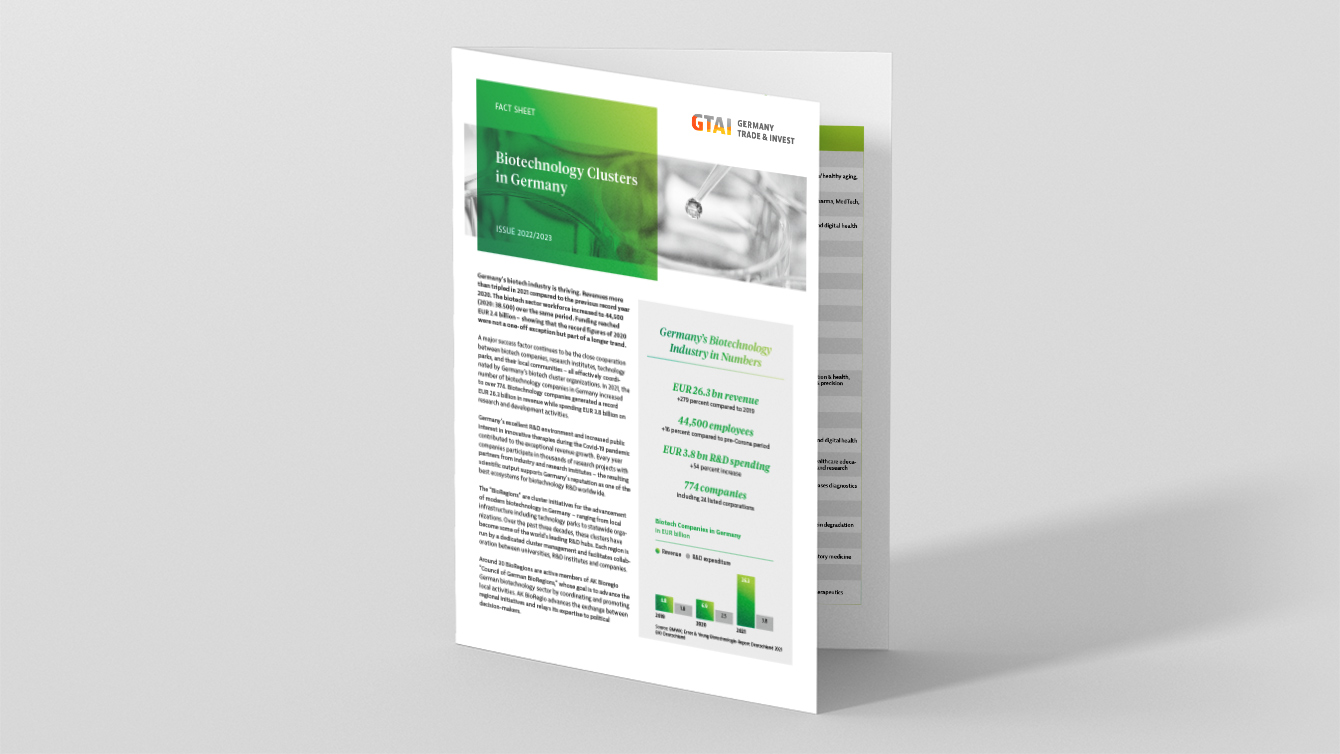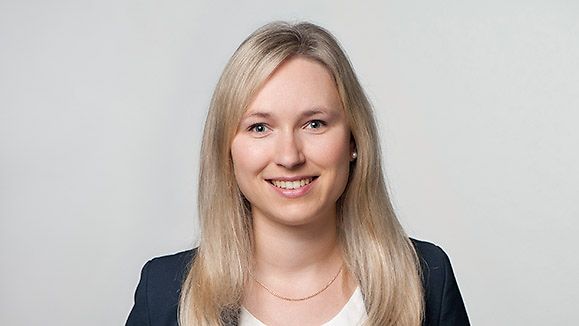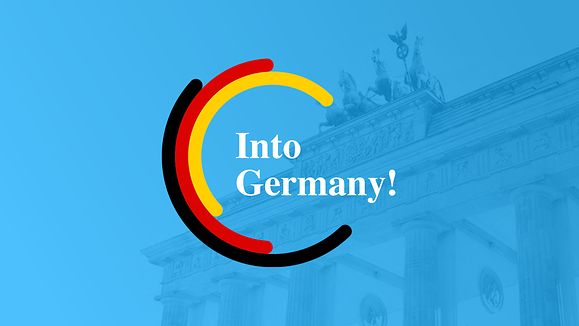pharmaceutical industry revenue in Germany in 2023 (in EUR)
Your company is already operating in Germany and you would now like to export worldwide?
Key Facts
Facts & Figures
Europe’s Biggest Pharma Market
Germany constitutes the major European pharmaceutical market and the fourth largest worldwide, after the US, China and Japan. Driven by trends such as demographic change, a rise in chronic diseases and an increasing emphasis on prevention and self-medication, Europe’s biggest pharmaceutical market is growing faster than the German economy. In 2023, pharmaceutical industry sales in Germany increased by 5.8 percent, reaching EUR 59.8 billion (ex-manufacturer prices).
Global R&D Leader
Germany belongs to the world’s leading clinical trial locations and - based on R&D investment and patent application levels - is the leading pharmaceutical innovation location in Europe. In 2022, pharma companies in Germany invested EUR 9.6 bn in R&D, and some 613 patents were registered with the European Patent Office by the pharmaceutical industry in Germany.
Leading Pharmaceuticals Supplier
The country is the largest exporter of medicinal products and ranks among the top pharmaceutical producers worldwide. In light of the global need for personalized medicine, Germany has also evolved into one of the main suppliers of novel biopharmaceuticals.
Opportunities
Opportunities in Germany’s Pharmaceutical Industry
- Prescription Drugs
Revenues in the prescription drugs segment generated via brick-and-mortar and mail-order pharmacies grew by almost 6.0 percent per year between 2018 and 2023 (+5.4 percent in 2023), reaching almost EUR 65.3 billion in 2023 (ex-pharmacy prices). Prescription-only medicines accounted for almost 90 percent of drug sales revenue and for around half (almost 800 million packaging units) of the sales volume of medicinal products in the pharmacy market. Germany´s ageing society and the high prevalence of chronic and long-term diseases will continue to drive demand for prescription drugs in the German market.
Over-the-counter (OTC) Market
Revenue in the German OTC market increased by 4.5 percent per year on average between 2018 and 2023 (+7.3 percent in 2023), reaching almost EUR 12.9 billion in 2023. This corresponds to almost 1.7 billion packaging units. More than EUR 8.3 billion of revenue was generated in the non-prescription drugs segment and around EUR 4.5 billion with health products that are not subject to pharmaceutical legislation, e.g. food supplements.
Remedies for the respiratory system, analgesics and products for the digestive system account for the highest share of non-prescription drug sales via pharmacies. Although self-medication constitutes the lion’s share of OTC revenue, OTC products may also be prescribed and reimbursed by health insurers.
Over-the-counter medicines may be dedicated to treating relatively minor ailments such as colds. Many consumers are also willing to spend money on products that support personal wellbeing, e.g. food supplements. Growing health awareness levels and a focus on prevention displayed by many consumers in Germany contribute to positive future prospects in the OTC segment.Biopharmaceuticals
Because of their high therapeutic potential, biologics have taken up a considerable share of the pharmaceutical market in Germany. In 2023, revenue of biopharmaceutical manufacturers in Germany grew by 8.9 percent to EUR 19.2 billion – equivalent to one third of the total pharmaceutical market.With growth rates of 17 and 9 percent respectively, oncology and immunology remained the highest-revenue segments in 2023. Together with metabolic disorders, those three indication areas represent almost three quarters of total biopharmaceutical sales in Germany.
Full R&D pipelines with many clinical studies focussing on oncology – followed by infectious diseases – contribute to a vibrant biotech ecosystem. The innovative strength of the German biotechnology sector and the diverse application possibilities of artificial intelligence will most probably further enhance industry growth.
Business Environment
Germany is the perfect location for pharmaceutical R&D, production, and sales of medicines. We welcome international enterprises who seek to become a part of the country’s thriving life science ecosystem.
Attractive Pharma Production Location
Germany is one of the world’s top pharmaceutical production locations. In 2022, pharmaceutical production volume reached EUR 37.4 billion – equivalent to 8.2 percent year-on-year growth.
Together with Belgium and Italy, Germany belongs to the biggest pharmaceutical manufacturing locations within the European Union. In addition to local industry players like Bayer and Boehringer Ingelheim, many international pharmaceutical companies – including GlaxoSmithKline, Pfizer, Roche, Sanofi, and Takeda – operate production facilities in Germany.
Germany is the second-largest producer of biopharmaceuticals approved in the European Union, only surpassed by the USA. Three important factors contributing to this excellent position are the high-performing industrial infrastructure, the longstanding strength of the local chemical industry, and a highly qualified workforce.
Excellent R&D Environment
Germany provides the perfect environment for the development and production of research-intensive, high-grade products. In 2022, the pharmaceutical industry in Germany invested over EUR 9.6 billion in R&D – far more than any other EU country. The German pharma sector shows the highest research intensity across all major German industries – about 11.1 percent of revenues were reinvested in internal R&D projects in 2020 and the total research intensity reached 16.5 percent.
Based on the number of patent applications, the country is also leading in pharmaceutical innovation in Europe. In 2022, some 613 patents were registered with the European Patent Office by the pharmaceutical industry in Germany. With 524 clinical trials financed by research-based pharmaceutical companies in 2022, Germany ranks second in the EU and fourth worldwide after the USA, China and Spain respectively.
Over 30 biotechnology clusters bundle scientific expertise at a regional level and connect academic and industrial players in the field of drug development, thereby contributing substantially to the advancement of pharmaceutical innovation and creating an innovation ecosystem that enjoys global acclaim.
- Strong and Supportive Associations
International pharmaceutical companies can benefit from a well-established association landscape representing the interests of the pharmaceutical industry in Germany and positively shaping the business environment. Major organizations include:
BPI – German Pharmaceutical Industry Association: www.bpi.de
Pharma Deutschland: www.pharmadeutschland.de
vfa – German Association of Research-Based Pharmaceutical Companies: www.vfa.de
Pro Generika – German association of generics and biosimilar manufacturers: www.progenerika.de
Recognizing the crucial importance of the pharmaceutical sector, the German government released a pharma strategy in 2023 to further enhance the attractiveness of Germany as a pharmaceutical R&D and production location.



